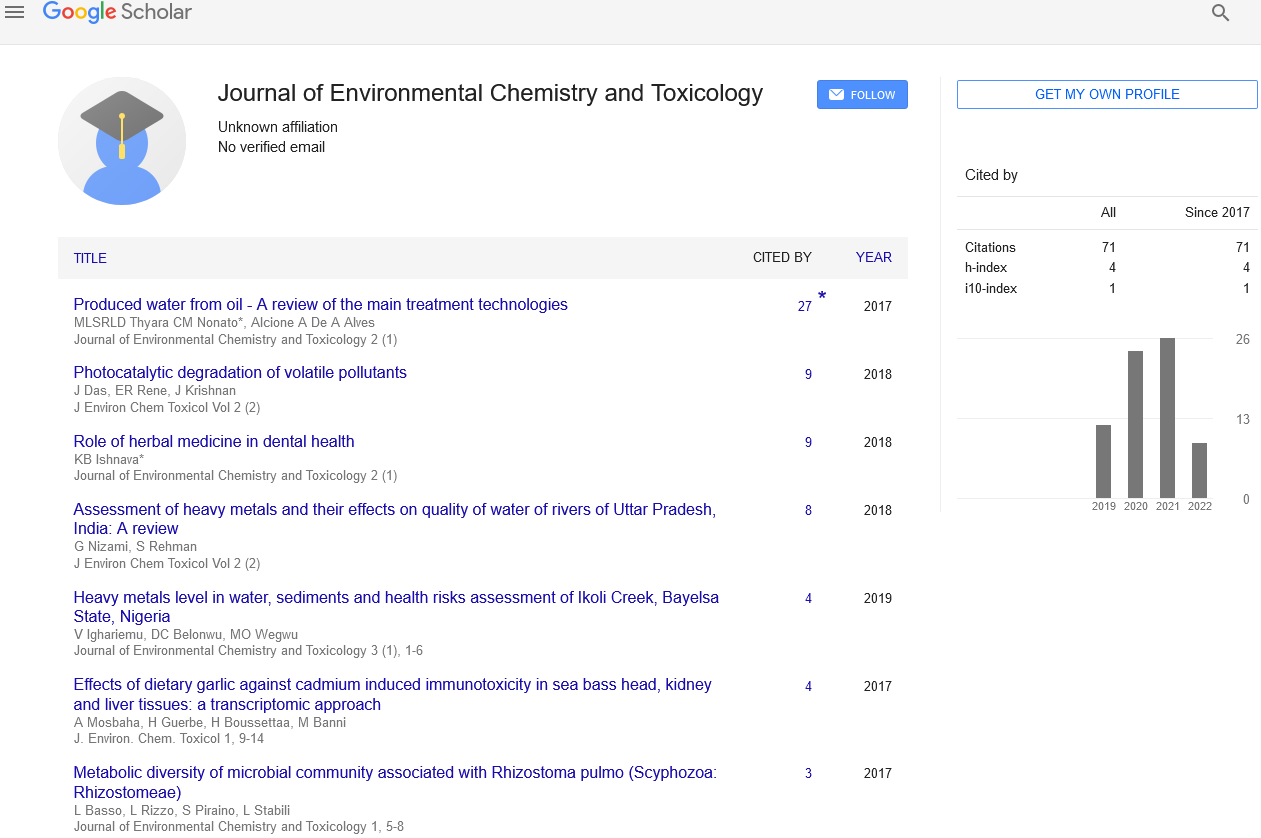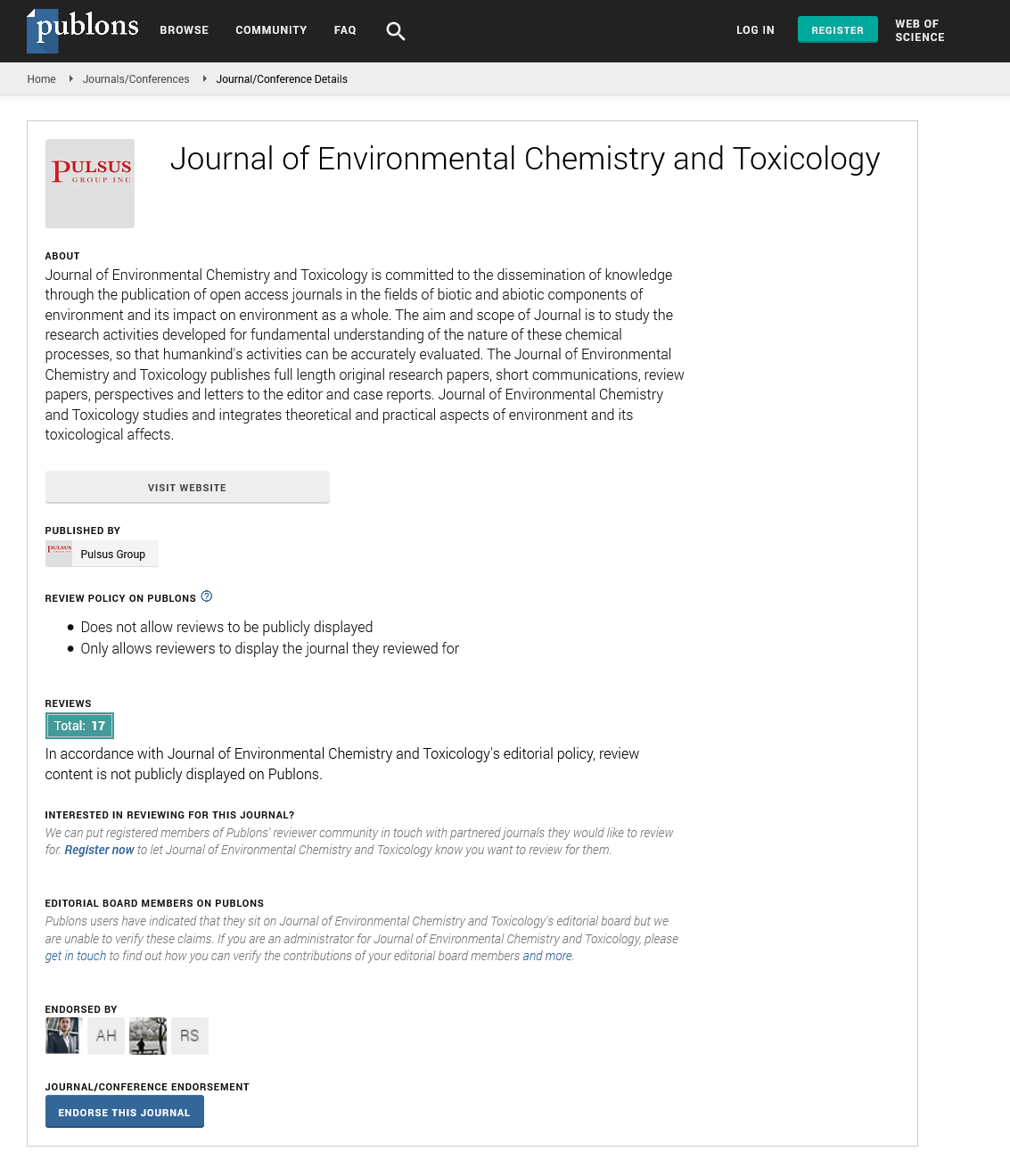Discussing recent trends in abrupt global warming, the slowing of the warming trend, and related phenomena
Received: 14-Jul-2022, Manuscript No. PULJECT-22-5429; Editor assigned: 18-Jul-2022, Pre QC No. PULJECT-22-5429(PQ); Accepted Date: Aug 23, 2022; Reviewed: 12-Aug-2022 QC No. PULJECT-22-5429(Q); Revised: 16-Aug-2022, Manuscript No. PULJECT-22-5429(R); Published: 24-Aug-2022, DOI: 10.37532/ pulject.2022.6(5);35-36
Citation: James G. Discussing recent trends in abrupt global warming, the slowing of the warming trend, and related phenomena. J Environ Chem Toxicol. 2022; 6(5):35-36
This open-access article is distributed under the terms of the Creative Commons Attribution Non-Commercial License (CC BY-NC) (http://creativecommons.org/licenses/by-nc/4.0/), which permits reuse, distribution and reproduction of the article, provided that the original work is properly cited and the reuse is restricted to noncommercial purposes. For commercial reuse, contact reprints@pulsus.com
Abstract
Although the fundamental explanation is still unknown, the mystery surrounding the recent halt in the global warming trend has attracted significant interest. This analysis addresses that topic by separating the influence of CO2-led linear anthropogenic contributions from those of natural forces (the sun and volcano). It separates the years 1976–1996 into two complete solar cycles, during which two explosive volcanoes erupted during active solar cycle phases. Furthermore, the time frame coincided with the duration of the abrupt global warming. It notes the importance of the Central Pacific ENSO's dominance and related water vapour feedback during that time. An explosive volcano's favoured alignment of the NAO phase could start the potential mechanism. It has caused the extratropical Rossby wave to affect the Aleutian Low. CP ENSO with a modulating effect. From that perspective, it is also possible to explain the disruption of the ENSO and Indian Summer Monsoon during the sudden warming episode and the following recovery. Interestingly, neither the CMIP5 model ensemble nor any of the individual models can account for this observation. It also considers potential regions where models might be missing significant contributions because of natural drivers.
Key Words
Bimolecular condensates
Introduction
Since 1976/1977, the global temperature has increased at an unheard-of rate. Coupled modelling communities that used all forces were able to accurately depict that upward tendency. CMIP (Coupled Model Inter-comparison Project) models primarily use solar, volcanic, and longer-term linear forcing (to represent anthropogenic CO2). The sudden increase in temperature was accompanied by unexpected global and regional climate patterns, among other things. The fact that known primary climate modes are coupled together also pointed to deviations. Numerous physical changes in the ocean and atmosphere during the years 1976 and 1977 were identified as a climate "regime shift" by studies.
Significant evidence suggests that in 1998, physical conditions around the oceans and the atmosphere changed as well. Since then, the temperature trend has been observed to be barely rising. In contrast to past periods, its temporal fluctuation did not agree with the ensemble results from the CMIP model and even fell outside of the ensemble spread range. Numerous studies have noted and examined the recent pause in the warming trend and have labelled the period as the "global warming hiatus phase." That peculiar quality is still a significant mystery and merits further investigation. Since 1998, other climate trends have also changed. Similar to temperature, a few other features/teleconnections that may have indicated aberrations in the interval between 1976 and 1997 are described here.
Different types of ENSO have been hypothesised in recent years based on the regional variability of tropical Pacific SST, with the Central Pacific ENSO being one of the most significant. It is mostly controlled by the SST fluctuations in the CP region. The main factor influencing CP ENSO is atmospheric forcing, which also has an extratropical relationship. It's interesting to observe that since the 1970s, CP ENSO has been more persistent and common, and that variability has increased unpredictably throughout the last century. It is yet unknown what changed the behaviour of the CP ENSO. According to a new study, CP ENSO is one of the causes of the present cooling trend or warming hiatus.
Additionally, the regional monsoon-ENSO relationship saw a common turning point in the 1970s, followed by a rebound in the late 1990s. The link between the western North Pacific, North American, Northern African, and South American summer monsoons improved during the intercepting period. Interestingly, over the same time span, the ISM's teleconnection deteriorated. Therefore, it is justified to split the time period 1976–1998 to separate the contribution of natural variables from CO2-led linear human contributions.
The main source of energy for the earth's climate is the sun. One type of natural disaster that has a significant impact on the earth's climate is explosive volcanoes, which affect both the troposphere and the stratosphere. In the years between 1976 and 1998, two significant volcanoes erupted in 1982 and 1991. Unlike other times before, those coincided with solar cycle active years, which were more powerful. Additionally, during that time, there were two complete solar cycles, beginning with one minimum and concluding with another.
It is appropriate to take the years 1976–1996 into account when analysing the combined impact of the sun and volcano (including phasing). Separating the period of those two decades, according to a study, would provide more clarity on certain climate variables that are also backed up by recent investigations. It is noteworthy that taking 1976–1998 into account—adding two more years—does not alter our key conclusions.
Emile-Geay et al.'s investigation into the function of explosive volcanoes revealed that they had a discernible impact on the ENSO model. Studies also indicated an increase in the chance of warm ENSO episodes and revealed nearly twice the likelihood of an El Nio occurrence in the winter following a volcanic eruption using observational data from longer-term paleoclimate datasets. Also supporting it are the modelling studies.






